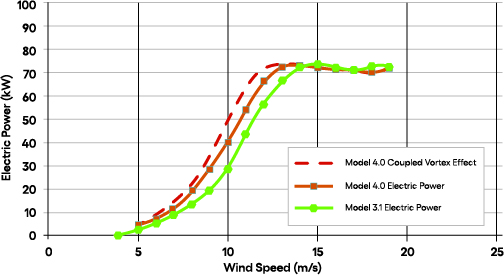Each Wind Harvester comes with a 50, 70, or 75kW generator, depending on the wind resource. In places like Barbados, where mid-level wind speeds rarely exceed 22 mph (10m/s), using a smaller, 50kW generator lowers the cost of the turbine while losing little energy produced. Sites with wind speeds averaging closer to 19 mph (8.4m/s), such as Simpson Ridge in WY need a 75 kW generator to turn the many hours of higher wind speeds into extra energy. Most projects will use a 70kW generator, which we will use here to explain how much energy Wind Harvesters produce.
By selling our turbines in pairs or longer arrays, clients are able to take advantage of the 10-20% increase in energy output that our technology creates. The table to the right shows the energy output of a pair of 70kW turbines at different wind speeds. The Capacity Factor is calculated by dividing the energy produced by the total energy possible from a turbine that operated for 8760 hours at its full capacity for a year (613 MWh).
The energy produced by Wind Harvesters in different average annual wind speeds is calculated from its projected power performance curve matched against a Rayleigh wind bin speed distribution (e.g. how many hours per year does the wind blow at 12, 13, 14 etc mph).
| Wind Speed (m/s) | Wind Speed (mph) | MWh/year per turbine pair | MWh/year per MW | Capacity Factor |
|---|---|---|---|---|
| 5.0 | 11 | 134 | 957 | 10.9% |
| 5.5 | 12 | 244 | 1,743 | 19.9% |
| 6.0 | 13 | 302 | 2,157 | 24.6% |
| 6.5 | 14.5 | 362 | 2,586 | 29.5% |
| 7.0 | 16 | 422 | 3,014 | 34.4% |
| 7.5 | 17 | 478 | 3,414 | 39% |
| 8.0 | 18 | 532 | 3,800 | 43.4% |
| 8.5 | 19 | 582 | 4,157 | 47.5% |
| 9.0 | 20 | 628 | 4,486 | 51.2% |
| 9.5 | 21 | 670 | 4,786 | 54.6% |
| 10 | 22 | 708 | 5,057 | 57.7% |

Power Performance Curve
This image compares the power performance of the Wind Harvester Models 3.1, 4.0 and 4.0 with the coupled vortex effect.


